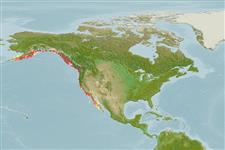Common names from other countries
Environment: milieu / climate zone / depth range / distribution range
экология
; пределы глубины 0 - 46 m (Ref. 95344). Boreal, preferred 8°C (Ref. 107945); 60°N - 22°N, 166°E - 109°W
Pacific Ocean: West to east Bering Sea, Aleutian to Baja California.
Length at first maturity / Size / Вес / Возраст
Maturity: Lm ?, range 2 - 3.5 cm Max length : 7.5 cm SHL самец/пол неопределен; (Ref. 95344); common length : 6.4 cm SHL самец/пол неопределен; (Ref. 78182); наибольший возраст (опубликованны данные): 16 годы (Ref. 104675)
Maximum depth from Ref. 104447. Buries in gravel, sand and mud to more than 10 cm deep along the mid-intertidal zone (Ref. 95344). Preyed upon by naticid gastropods (Ref. 100855). Suspension-feeder (Ref. 78182). In general, suspension feeding bivalves mainly depend on phytoplankton and detritus material for nutrition (Ref. 107088).
Members of the class Bivalvia are mostly gonochoric, some are protandric hermaphrodites. Life cycle: Embryos develop into free-swimming trocophore larvae, succeeded by the bivalve veliger, resembling a miniature clam (Ref. 833). Eggs are discharged through the siphon (Ref. 104667). Spawning: Two periods of high temperature and two spawning peaks may occur in summer due to strong water temperature fluctuations while only one temperature and spawning peak may be expected in a warmer than normal year (Ref. 78182).
Основная ссылка
ссылки | координатор | соавторы
Shaw, W.N. 1986. (Ref. 78182)
Статус Красного Списка МСОП (Ref. 130435)
Статус СИТЕС (Ref. 108899)
Not Evaluated
Not Evaluated
Использование человеком
рыболовство: коммерческий
FAO - аквакультура (рыбоводство): production; рыболовство: landings | FishSource | Sea Around Us
инструменты
дополнительная информация
ресурсы в Интернет
Estimates based on models
Preferred temperature
(Ref.
115969): 7.3 - 15.7, mean 9.8 (based on 90 cells).
устойчивость к внешним воздействиям
средний (среднего размера), минимальное время удвоения популяции 1.4-4.4 года (K=0.19; tm=2.5; tmax=16).
